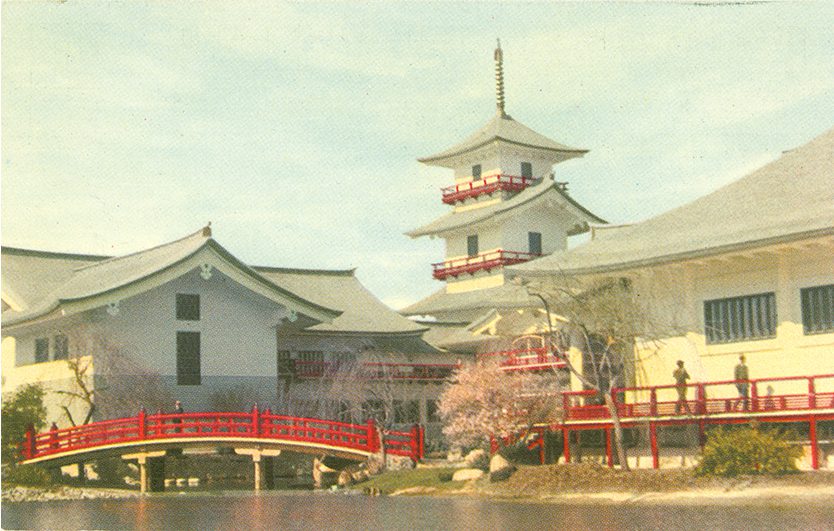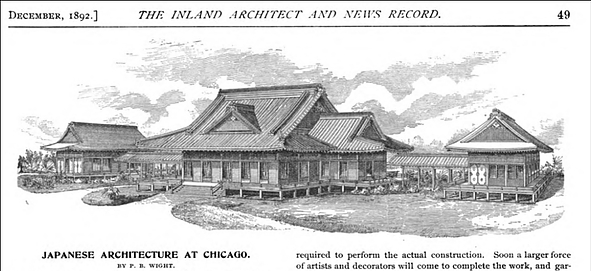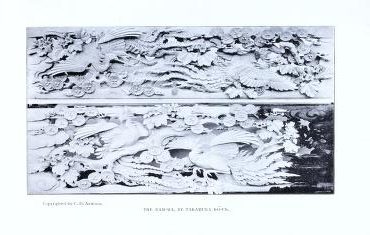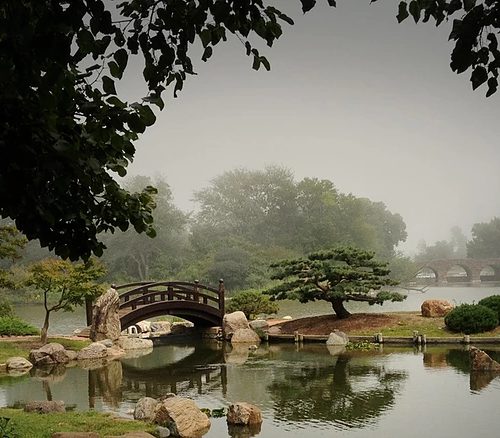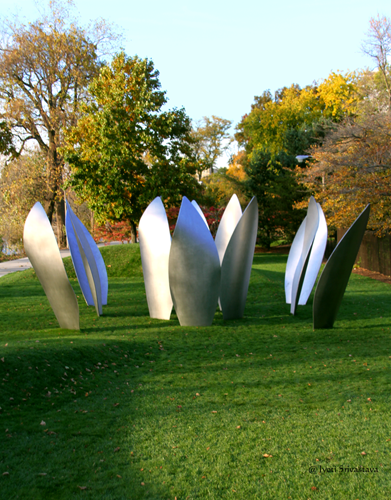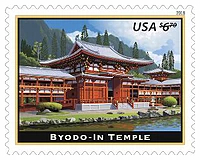Room No. 3
After the Fair
The Remains and Legacy of the Ho-o-den
Garden of the Phoenix, Jackson Park’s Wooded Island. Chicago, IL.
Source: Chicago Tonight
The Ho-o-den Lives on After the Fair
World’s fair architecture was built to last for just the duration of the event, using construction materials that were experimental and innovative but not necessarily long-lasting. Although the majority of the structures were demolished after the close of each fair, one to two structures typically survived the purge to serve as permanent civic institutions. For example, the Palace of Fine Arts at the World’s Columbian Exposition remained on site in Chicago and has housed the Museum of Science and Industry since the 1930s to the present. Occasionally, interested buyers paid for and transported an entire exhibition building to another location. To name just two examples: 1) The British company Alexander Park purchased the Japanese pavilion and garden exhibited at the 1873 Vienna exposition and moved them to London; 2) the American tycoon Cornelius Kinsland Billings purchased the Norway Building at the World’s Columbian Exposition and moved it to Lake Geneva, Wisconsin (it has since changed owners and locations multiple times, and as of 2017, repatriated to Norway).
Japan’s pavilion in Chicago, known as the Ho-o-den, was one of the few fair structures designed to remain on site. Its introduction to a wide audience in 1893 made a great impression on American understanding of Japan as a major cultural force. Both the structure and surrounding garden served as permanent physical reminders of the excellence of Japanese design, artistry, and craft. It is possible to think of the Ho-o-den making a lasting impact in two major ways: 1) its location on the Wooded Island has served as a continuous symbol of friendly US-Japan relations, maintained even after the Ho-o-den structure itself burnt down in 1946; 2) it pioneered an architectural vocabulary based on historical-religious styles that subsequent Japanese pavilions erected at 20th-century American fairs followed. The stylistic influence spread widely, beyond the fairgrounds, to entertainment, restaurant, and even private home designs that invoked Japan. A tourist favorite has been the Japan Pavilion of the World Showcase at Walt Disney World’s Epcot Center, where a Shinto gateway, feudal castle, Buddhist pagoda, and imperial palace come together to represent Japan.
“One of the great benefits to be derived by the city of Chicago from the World’s Columbian Exposition will be a permanent building (or rather group of buildings) now being erected at Jackson Park by the Japanese Imperial Commission, illustrating not only the old architecture of Japan, but the exact method of construction employed in that country during the best periods of its arts, ranging from four hundred to eight hundred years ago…”
— The Inland Architect and News Record (December 1892)
“The buildings on Wooded Island are unique in design and construction. They are intended to illustrate three different epochs of Japanese architecture…[and] will consist of three separate buildings, connected by wide corridors, and so arranged as to possess an air of general architectural unity…The Ho-oden has been presented to the city of Chicago, and will pass under its control at the close of the Exposition.”
— The North American Review (January 1893)
A Japanese Gift to the United States
After the close of the World’s Columbian Exposition, the Chicago fair site reverted to parkland as Jackson Park. This required the removal of the monumental assembly of exhibition buildings, although an exception was made for the Ho-o-den, which stood on the scenic Wooded Island. Intended from the time of its initial construction, the pavilion was a permanent gift that the Japanese government left to the city.
The gifting represented a significant diplomatic gesture for both the giver and recipient. Gozo Tateno, the Japanese Minister in Washington DC, used his nation’s displays as evidence of Japan’s progress and prosperity. He urged the United States to recognize Japan’s worthiness as a political, cultural, and economic equal as the latter lobbied for a revision of the unequal treaties originally signed in the 1850s between the two nations.
American architect and critic P. B. Wight voiced his appreciation of the Ho-o-den for its historical authenticity and traditional craftsmanship, noting that his fellow designers had much to learn from its artistry. The diminutive size of the Japanese pavilion and its unpainted woodwork allowed it to blend seamlessly with the naturalistic greenery and water features of the Wooded Island, originally envisioned by the landscape designer Frederick Law Olmsted as a respite zone free of buildings (he conceded to the Japanese imposition as the best possible compromise).
The Ho-o-den Destroyed by Fires
Despite serving as a symbol of good will between Japan and the United States, the Ho-o-den did not fare well in Jackson Park. By 1933, “vandals and souvenir hunters” had ravaged the structure to the extent that few of the original panels within the interior remained intact. After Chicago held another world’s fair in 1933, bringing another opportunity for attention to Japanese culture through national display, restoration of the Ho-o-den at long last took place. Completed in 1935, the reactivated pavilion and surrounding garden flourished as a concession and scenic retreat.
The structure fell into disrepair once again after the Japanese attack on Pearl Harbor in 1941. Numerous other Japanese pavilions and gardens in the United States were similarly neglected during wartime due to resource shortages as well as anti-Japanese sentiments (for example, the Japanese House at the Huntington and the Japanese Tea Garden in San Antonio).
After the war, two separate fires broke out in 1946, on June 21 and October 12, that ultimately destroyed the Ho-o-den. The cause of the first fire was unknown, whereas the cause of the second was arson.
Adolescent arsonists started a fire next to the Ho-o-den “just to see it burn”; the park police arrested them at the scene. The building was irreparably damaged.
Remains of the Ho-o-den
Three painted sliding doors (fusama) from 1893 World’s Columbian Exposition.
Source: Hyperallergic
Remains of the Ho-o-den discovered
Decades after fires destroyed the structure, fragments of the Ho-o-den resurfaced in unlikely places.
In 1973, four transom panels, known as ranma in Japanese, were discovered in storage under the bleachers of Soldier Field Stadium. The panels have been conserved and partially restored and are now on permanent display at the Art Institute of Chicago. See the curator Janice Katz’s narration of the exciting discovery, separation, and reunion of the four ranma.
The ranma are described in the 1893 illustrated catalog of the Japanese Pavilion as “elaborate carvings of phoenixes” by Professor Takamura Kōun of the Tokyo Fine Art School.
Remains of the Ho-o-den discovered, cont.
In 2015, three of the original painted sliding doors, known as fusuma in Japanese, were discovered in a Chicago Park District storage facility. Just like the transom panels, they feature auspicious bird imagery, described in the 1893 illustrated catalog of the Japanese Pavilion as “male and female phoenixes at play with their young” painted by Professor Hashimoto Gahō of the Tokyo Fine Art School.
The fusuma panels, along with the ranmapanels, are now part of the permanent collection of the Art Institute of Chicago.
Legacy of the Ho-o-den
The Garden of the Phoenix in Jackson Park, Chicago.
Source: Flickr
The Wooded Island as Lasting Celebration of Japanese Art
By 1960, no trace of the original Ho-o-den and surrounding garden remained on the Wooded Island, except for a single stone lantern. Efforts to restore the garden were initiated in 1960, and again throughout the 1970s. On 21 June 1981, Chicago mayor Jane Byrne, Japanese Consul General Yoshinao Odaka, and Park District Superintendent Edmund Kelly presided over the dedication ceremony for the renovated garden.
In recognition of the 20th anniversary of the sister city relationship between Chicago and Osaka, the garden was renamed Osaka Garden in 1993. Most recently, in 2013, the name changed once again, to the Garden of the Phoenix to mark the 120th anniversary of the gifting of the Ho-o-den to the American city.
In addition to restoring the garden, the non-profit Garden of the Phoenix Foundation planted 120 cherry trees in Jackson Park in 2013 to mark the anniversary of the original erection of the Ho-o-den. On the site of the now-lost pavilion, the organization commissioned a sculpture titled Sky Landing, installed by Japanese-American artist and musician Yoko Ono in 2016.
While the 1893 Ho-o-den offered a didactic history lesson on Japan (it showcased a millennium of historical progress through changing cultural-political regimes and attendant transitions in architectural features and artistic styles), the gardens and artwork that have replaced it on the Wooded Island after 1946 do not make reference to specific times, politics, or regions of Japan. They present instead a neutralized, timeless Japan that is visually distinct from mainstream Euro-American aesthetics.
A Phoenix Hall Replica in Hawaii
Another replica of Japan’s Hōōdō (Phoenix Hall) of the Byōdōin temple complex was created in the United States, this time in 1968 in Hawaii to celebrate the centenary of the arrival of the first Japanese immigrants to this state.
Named the Byodo-in Temple, it is a reduced-scale, reinforced-concrete replica of the Phoenix Hall located in the Valley of the Temples Memorial Park on Oahu island. In imitation of the 11th-century Japanese original, the building houses an Amida Buddha sculpture as its main icon. However, the Hawaiian Phoenix Hall is non-denominational, welcomes worship and meditation, and hosts weddings and events. It frequently appears in television shows and movies as Hawaiian scenery, and at times acts as a stand-in for Japan or Asia at large (in the 2004-2010 television drama Lost, it was the setting of a wealthy Korean businessman’s estate).
The Byodo-in Temple, like the Ho-o-den, functions as a general signifier of Japanese architecture and culture in the United States and celebrates an ongoing cultural connection between the two countries. It is one of several replica Japanese monuments in Hawaii. Others include the Izumo Taishakyo Mission (1923) inspired by the form of the Izumo Grand Shrine, the pavilion at Kyoto Gardens Kinkaku-ji (1966) inspired by the Kinkakuji (Golden Pavilion), and the Makiki Christian Church (1931) inspired by the Himeji Castle.
Japanese Pavilions at
20th-century American Fairs
Japan Tea Hall at the Century of Progress International Exposition, Chicago, 1933.
Source: Fresno State. Henry Madden Library
Japanese Pavilions at 20th-century American Fairs
Japan actively participated in international expositions held in the United States, starting with the 1876 Centennial Exposition in Philadelphia and continuously up to the twin exhibitions of 1939 held on the two coasts (one in San Francisco and the other in New York).
The Japanese pavilions constructed at each fair consistently engaged architectural styles that appeared distinctly “Japanese.” Historical styles and traditional building types served as models for the pavilion designs (castles, pagodas, and shrines were most typical), although close replication of a specific building in the same vein as the Ho-o-den would not be common.
The constancy of the Japanese pavilions clothed in historical styles stood out against the progressively changing architecture of the expositions’ main buildings. Fairs in the 20th century typically trumpeted future vision, and they featured modern designs that carried little to no direct references to the past.
Louisiana Purchase Exposition
-
1904
St. Louis, Missouri
Alaska-Yukon-Pacific Exposition
-
1909
Seattle, Washington
Panama-Pacific International Exposition
-
1919
San Francisco, California
Century of Progress International Exposition
-
1933
Chicago, Illinois
Golden Gate International Exposition
-
1939
San Francisco, California
New York World's Fair
-
1939
New York, New York



